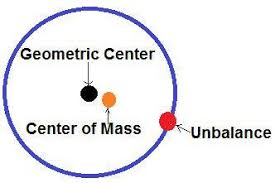
When I started balancing fans many years ago, I stopped balancing when:
- The fan owner said, “that’s much better”, because the machine wasn’t bothering them anymore
- When I got the fan below 2 mils (PK-PK)
- When I couldn’t get it any better
None of these are very scientific, so let’s look at some specifications.
ISO 1940/1 covers balance grade qualities for many different types of machines – from slow-speed reciprocating engines, all the way down to gyroscopes. In the cases of most industrial machines, the specification is G 6.3. The 6.3 denotes the amount of residual vibration at running speed, in mm/sec.
Some high speeds applications, or electric motors operating “stand alone” might specify a G 2.5, or 2.5 mm/sec.
- G 6.3 = 6.3 mm/sec, or 0.248 in/sec (PK), or 0.175 in/sec (rms).
- G 2.5 = 2.5 mm/sec, or 0.098 in/sec (PK), or 0.069 in/sec (rms).
These are quite achievable, in most cases, IF unbalance is the only vibration at 1 times the rpm, and the machine is not operating in resonance. But there are other sources of vibration that manifest themselves at 1 x rpm, such as misalignment, a bent shaft, looseness, and so on.
So, how do you know “when to stop”?
Balancing is both a mathematical, and a logical process. If you add a correction weight to the right spot, you should expect the vibration to drop, and the phase angle to stay relatively steady. Even a trim run should be predictable. But if the vibration amplitude or phase does not perform as expected, look for:
- Any looseness in the system, either in the machine, or in your sensor or tachometer. If none is found,
- Check for resonance. Is the machine operating at a natural frequency? You can test for resonance in multiple ways, from a bump test, to a coast down test, to just changing the input on a VFD drive.
- Are there other components that could cause vibration at 1 x rpm? Balancing can only effect balance quality, not misalignment, or other causes.
Lastly, most manufacturers of machinery specify balance quality for their machine. You should balance to the manufacturer’s recommendations.











